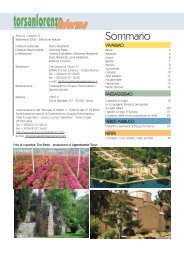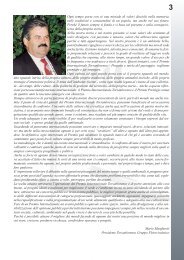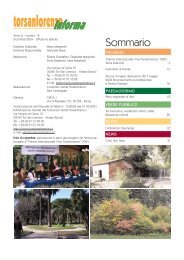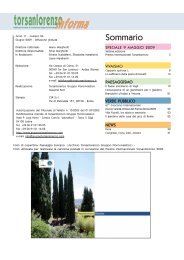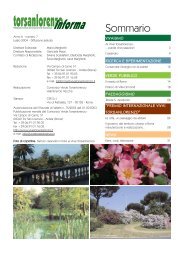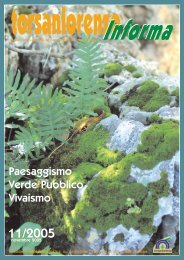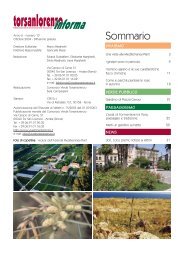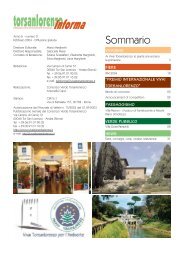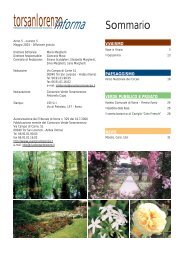Ottobre - Gruppo Torsanlorenzo
Ottobre - Gruppo Torsanlorenzo
Ottobre - Gruppo Torsanlorenzo
Create successful ePaper yourself
Turn your PDF publications into a flip-book with our unique Google optimized e-Paper software.
Fall Colours in Quebec:<br />
A Tour of the Morgan Arboretum<br />
PAESAGGISMO<br />
Christina L. Idziak – Curator, Morgan Arboretum<br />
Morgan Arboretum background<br />
Located in Quebec, Canada, on the island of Montreal,<br />
only 30km from the heart of the city, the 245ha Morgan<br />
Arboretum is a unique mosaic of remnant natural forest<br />
ecosystems, plantations, 18 collection plantings of<br />
native and non-native trees species, agricultural land,<br />
and open spaces. Acquired in 1945 by McGill<br />
University, this peri-urban forest has as its mandate the<br />
promotion of education, conservation and research<br />
relating to forests and trees.<br />
A walk through the Arboretum…<br />
Every year, as Fall approaches, the Arboretum gradually<br />
undergoes a marvellous transformation of colours.<br />
Due to the diverse geology of the site, there are approximately<br />
40 tree species native to Quebec growing in the<br />
natural forest areas. Leaves of each of these species turn<br />
their own distinct colour… A walk along the 25 km trail<br />
system permits visitors to experience this fall palette of<br />
reds, oranges, yellows, purples and browns.<br />
torsanlorenzo Informa<br />
Arboretum Morgan<br />
How and why do leaves change colour?<br />
As Fall approaches, and nights grow longer, trees begin<br />
to prepare for lower winter temperatures in the range of<br />
0 to -30 0 C. The first step trees take is to slowly form a<br />
barrier at the base of the leaf petiole (where the leaf<br />
attaches to the stem). A once two-way exchange of<br />
water and nutrients into and out of the leaf soon<br />
becomes one-way only away from the leaf. This oneway<br />
flow enables trees to conserve most nutrients from<br />
their leaves before they fall. Complete separation of the<br />
leaf from the stem is called leaf abscission.<br />
Next, the production of the photosynthetic pigments,<br />
chlorophyll (green), and carotenoids (carotene = yellow<br />
and xanthophyll = orange) stops. While both of these<br />
pigments are produced throughout the entire growing<br />
season, normally only chlorophyll can be seen due to its<br />
higher concentration in the leaf. When production ceases,<br />
the less stable chlorophyll begins to break down<br />
faster than the carotenoids. As the green colour fades,<br />
the now predominant carotenoids cause the leaf to<br />
become a shade of yellow. For many tree species,<br />
including white birch (Betula papyrifera Marsh.), green<br />
ash (Fraxinus pennsylvanica Marsh.) and ironwood<br />
(Ostrya virginiana (Mill.) K. Koch), this is their final<br />
fall colour before complete leaf abscission causes their<br />
leaves to fall to the ground.<br />
Finally, for a few species, another process occurs before<br />
winter rides in. As leaf abscission nears completion,<br />
sugars, produced by any chlorophyll that is not yet broken<br />
down, are often prevented from travelling through<br />
the almost complete barrier, and therefore may become<br />
trapped in the leaf. These sugars facilitate a colourless<br />
pigment (flavonol), always present in the leaf, to be<br />
activated by sunlight which results in the production of<br />
a red pigment called anthocyanin. If carotenoid and<br />
anthocyanin concentrations are equal, leaves appear<br />
orange, while if anthocyanins dominate, leaves appear<br />
bright red. Sugar maple (Acer saccharum Marsh.), red<br />
maple (Acer rubrum L.) and musclewood (Carpinus<br />
caroliniana Walt.) are three species that complete this<br />
step and display an orange or red fall colour. Conditions<br />
favouring anthocyanin production include sunny days<br />
and cool nights (slows transport of sugars out of<br />
leaves). Interestingly, because anthocyanin does not<br />
11



